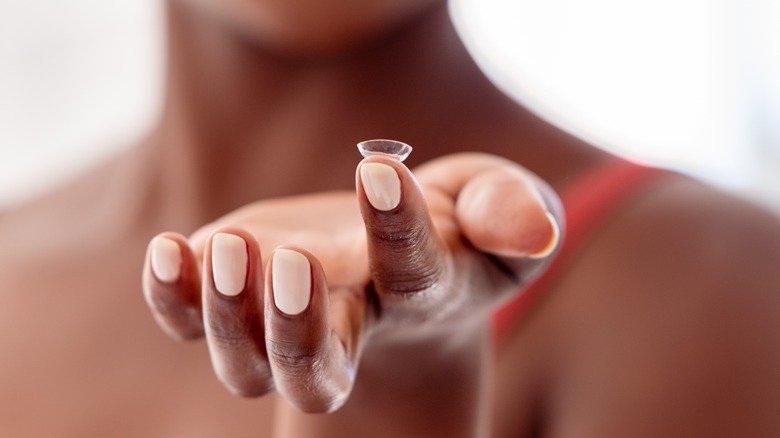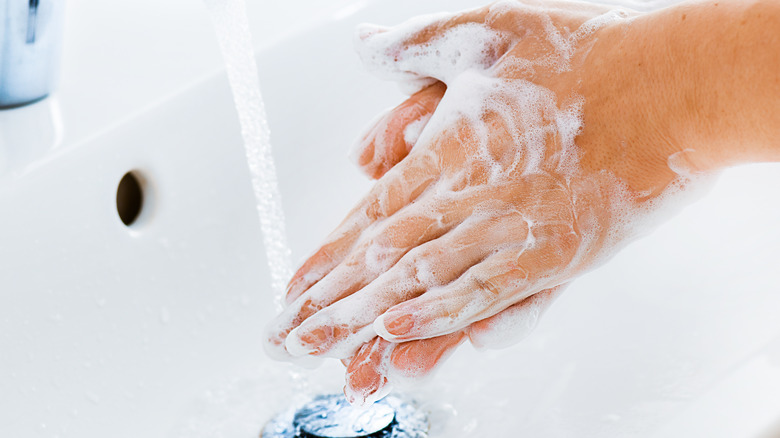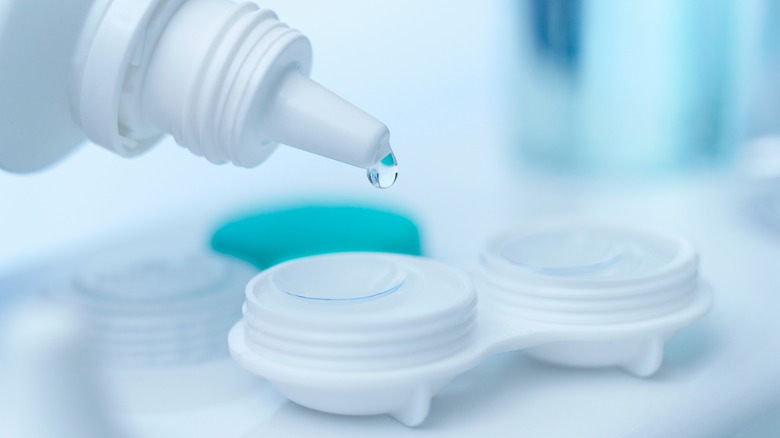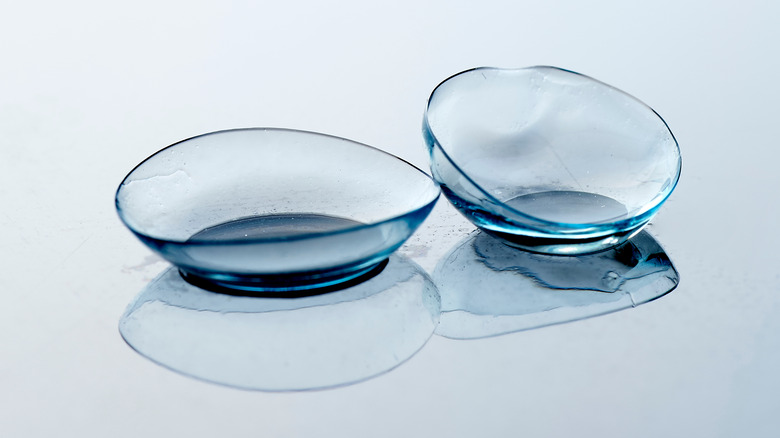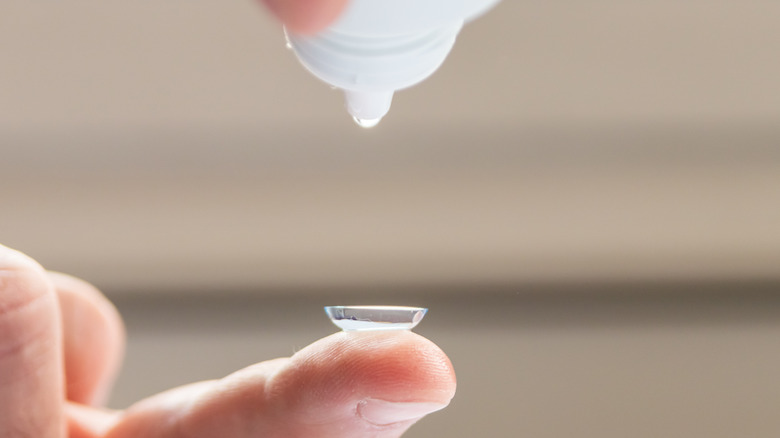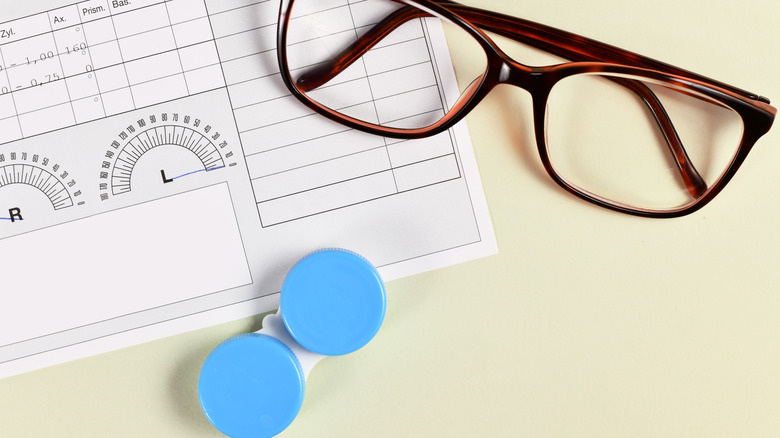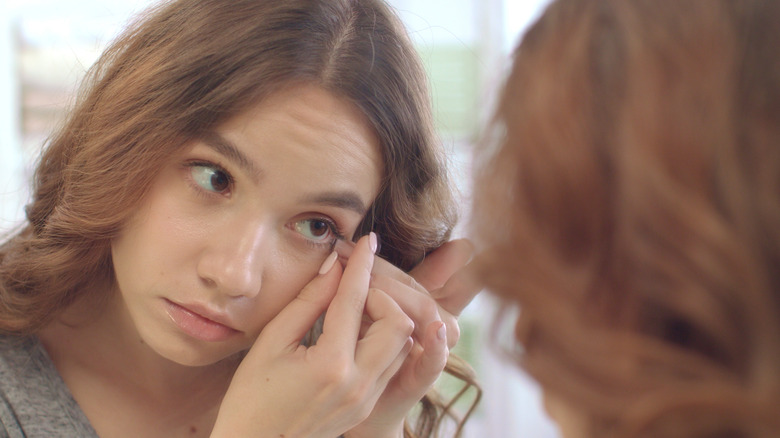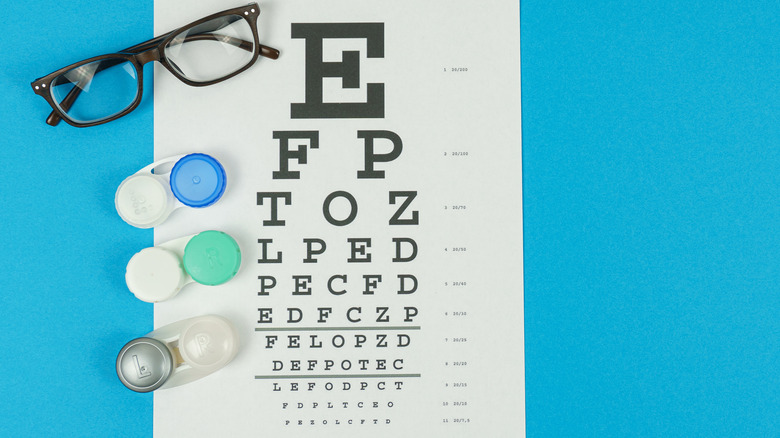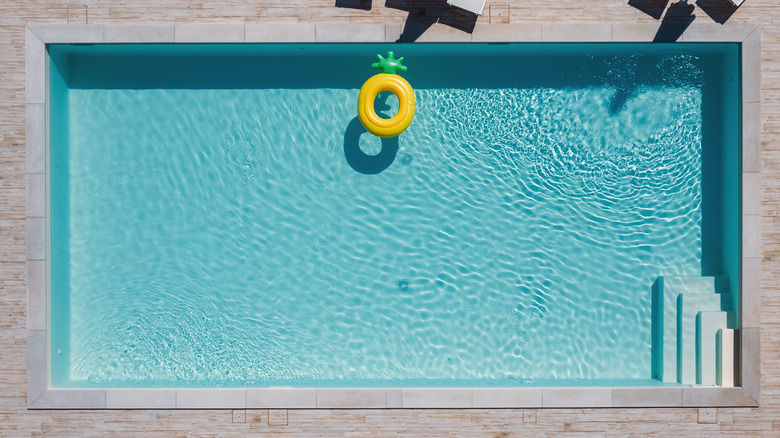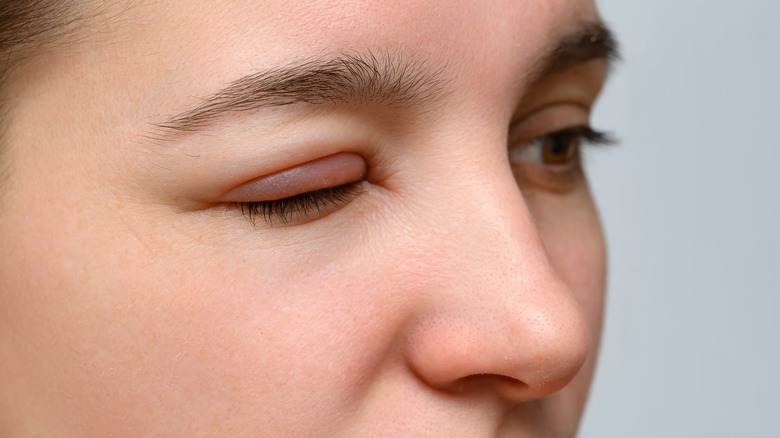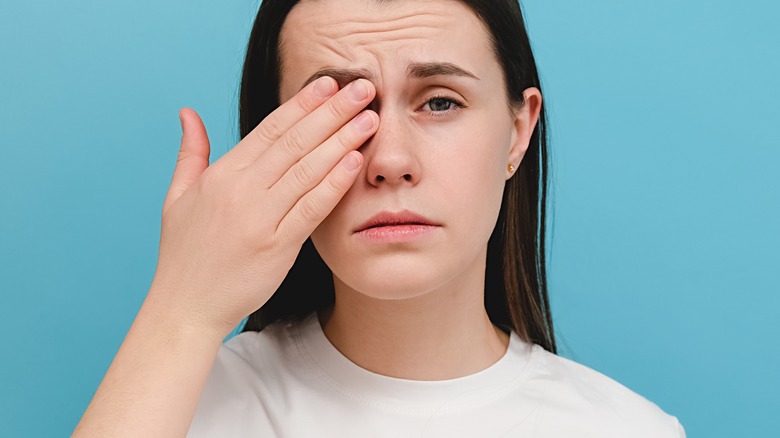Tips For People Who Wear Contacts
If you wear contacts, you're not alone. In fact, if you're in the United States, you're one of the roughly 45 million people who put contacts in their eyes in place of putting on glasses (per the CDC) and among the countless folks around the world who reap the benefits of clear vision they provide.
Contact lenses are a convenient way to improve sight daily, but for a lot of people, they can be a change of pace from wearing their spectacles. That said, anything that involves placing something directly into your eye every day comes with its own challenges — and when you start to manage your contact lens regimen poorly, things can start to go awry quickly.
But wearing contact lenses shouldn't be a nightmare. In fact, you may have already gotten yourself into habits that could be making your contact lenses more difficult than they need to be. With these simple tips, you can be sure you're wearing them safely, prolonging their lifespan, and keeping your eyes healthy. Let's take a look at our top tips for contact lens wearers.
First things first: wash your hands
Before you even start thinking about putting your contact lenses in, there's something else you need to tackle: your hand hygiene.
Washing your hands before you start handling your contacts is hugely important, and yet approximately 30% of people don't do it at all, according to a survey from The College of Optometrists (per Optometry Today). And that's a big problem. "Washing and drying your hands thoroughly will reduce the chance of acquiring a serious and potentially sight-threatening infection," says optometrist Daniel Hardiman-McCartney, with bacteria potentially traveling from your hands into the eye and resulting in some nasty business.
The solution? Wash those hands, people. Begin by dousing your hands thoroughly in water, and then rub soap first between your palms, then between your fingers (per Eyeland Opticians). Then, move to your wrists, rubbing each of them with your soapy hands in a regular motion, and then focus on the backs of your fingers and your thumbs. Finally, rub your nails in a circular motion on your palms to clean underneath them, before rinsing your hands well and drying them completely. And hey, presto! You're good to go!
Don't assume you can get by without contact solution
Contact lenses are a simple way to keep your vision 20/20, but let's face it — they're not exactly cheap. Depending on what type of contact lenses you're using, wearing them regularly can cost you up to $500 a year, according to Healthline. So it's little surprise that people are always looking for ways to keep costs down, and you might think that contact lens solution is an unnecessary expense that can be axed. We strongly advise against doing this, though.
Contact lens solution is vital to keep your lenses clean and free of infection, and swapping it out for water may lead to a host of unpleasant consequences for your eye health (per the CDC). Multipurpose solution is best for most people and can clean and disinfect your lenses effectively, but be careful to use fresh solution each time you change your lenses. If you have an intolerance or allergy to multipurpose solutions, your optometrist may supply you with a solution with hydrogen peroxide, but you must use it correctly (as per your optometrist's instructions) to avoid eye irritation.
Saline solutions are also widely used, although be advised that they don't have disinfectant properties, and instead should only be used alongside other solutions.
Know the different types and styles of contacts
It's easy to assume that a contact is a contact, and a lot of the time, whatever people are used to wearing is what they'll stick with for life. But there are a host of different contact lens types out there, and knowing the different styles could help you make the best choice for your individual needs.
Generally, people wear soft contact lenses, which fall into two distinct camps, disposable or extended wear (per the FDA). Disposable contact lenses, which most people opt for, are often used on a daily schedule, and are typically thrown away after one use. Extended wear contact lenses, on the other hand, are lenses that are designed to be used for a longer period (anywhere from a few nights to a month). While extended-wear contact lenses are useful for one-stop shoppers, you mustn't be keeping them in constantly, so that you can give your eyes a break.
Soft contacts aren't the only options available, though. Rigid glass permeable (or RGP) contacts may offer users a better clarity of vision overall, and could be less flimsy than their soft counterparts. However, they may be less intolerable to the eye, and can take a while to get used to.
When putting them in, it's good to follow a routine
If you're a bit of a maverick, we like your style. You're a free spirit, you live on the edge, and you're not bound down by rules, man. But frankly, even if you're someone who changes it up every day, one place you really shouldn't be pushing back against the status quo is when it comes to your contact lens routine. Keeping a routine when it comes to putting in your contact lenses will help you do it safely each time — and crucially, not mix up which lens goes in each eye — to keep in line with your prescription (per WebMD).
Start by placing your first eye's contact lens in front of you, and then gently slide the lens from its case into the middle of your palm. After dousing it with a solution to clean it, put it on your fingertip, ideally on your index finger. Then, use your other hand to hold your eye open from the top, and another finger on the hand with your contact lens on to keep it open from the bottom. Carefully place the lens onto your iris, sliding it into position if you need to, and then blink slowly. If you need to, you can also gently rub it with your eye closed. Repeat with the other lens, once the lens in your eye has settled.
If you're a first-time wearer, it's good to take it easy
Now, we're not gonna sugarcoat things here: Putting in contact lenses for the first time is pretty wild. Taking a little cap and placing it directly into your eye? Sorry, but it's not most people's idea of a good time. That's why, if you're a brand-new lens wearer, it's important to relax and take things slowly, as the experts at CooperVision say.
It's totally natural to feel as though the worst will happen (i.e., that the lens will disappear into the back of your eye and be lost forever), but trust us, that won't happen. And if you're nervous, there are a few things you can do to tackle your fears. Before you start to use lenses, try doing a "dry run," where you practice the movements of putting in a lens without actually inserting one, as the experts at PerfectLens suggest. This can help you get used to touching your eye and can assist in calming concerns about doing so. Just make sure that your hands are clean, of course.
It may also be worth spending some time holding your eyes open as if you were inserting a contact lens to acclimatize you to not blinking, which may be useful when it comes to putting them in.
Learn how to clean your lenses properly
When it comes to proper contact lens care, cleaning them thoroughly is pretty much the most important thing you need to learn, both to prolong the lifespan of your contacts and for your eye health. But the thing is, most of the time, we're only taught this the first time we get contacts, and never again.
That's why we think it's useful to break it down once more. Before you pick up or take out your lenses, make sure your hands are clean and dry, says optometrist Rachel M. Caywood (via the Dean McGee Eye Institute). If you're taking your lenses out, ensure that any old cleaning solution you use has been disposed of, so you're not mixing old with new. You should then clean the case out with a cleaning solution and wipe it with a paper towel. Take your lens out and put it in your palm, and then add a couple of drops of solution, rubbing it gently. Then, place it in the case, and fill it with cleaning solution to submerge it. You should also use a new case regularly, monthly if possible.
Don't assume that your prescription for glasses is the same for your contacts
So you're a glasses wearer, and you're getting contacts for the first time. You get to the bit on the webpage where you're entering your prescription, and you think "Well, that's just my glasses one, surely," and tap it in without a second thought. Or, maybe you've forgotten your glasses prescription — hey, it can happen — but you just sort of ... guess. How bad can it be?
Well, we'd advise against doing this. It's vital to have contact lenses properly fitted and a prescription given and updated regularly, as well as your glasses prescription (via VisionDirect). The reason for this is simply down to proximity (per Specsavers). While your glasses sit perched on your nose at a bit of a distance away from your eyes, your lenses are in your eyes, meaning that the strength of both needs to be different to ensure that you're seeing properly. If you're just transferring your glasses prescription to your contacts, your vision won't be as good as it could be. It's also important to remember that, like with glasses, prescriptions can be different for each eye.
Be careful when you're taking them out
It's only natural that people can get a little squeamish around eye stuff, particularly when it comes to touching them, and particularly when it comes to trying to fish something out of them. But learning how to take your contacts out safely every time will go a long way toward reducing that sense of unease around your precious eyeballs.
To start, make sure your hands are completely clean and thoroughly dry (per WebMD). Take your non-dominant hand (i.e., the one that you don't write with), and pull your upper eyelid open from above, using your middle or index finger to do so. Then, using the middle finger on the other hand, pull your lower eyelid down. The aim is to get as much of the eye exposed, so that your lens is easier to retrieve. Using the thumb and index finger in your dominant hand, gently pinch the contact lens to retrieve it and pull it out. If that's a little tricky to do, instead use your index finger to slide it to the bottom of your eyeball, to pinch it out there. Do the same with the other eye, and store your contacts immediately after removing them.
Learn what the specifics mean
Anyone who's ever looked at a box of contact lenses will likely have been a little flummoxed by what everything on it means. What, exactly, is a base curve? And does diameter refer to your eye's diameter, or the contact lens's diameter, or the diameter of the globe, or what?
Well, luckily, you don't have to be an optometrist to learn what these elusive terms signify. Your contact lenses will likely be created using three key categories: Power, base curve, and diameter (per Vision Direct). Power refers to, quite literally, how strong your lens's prescription is, whereas the base curve is the curvature of your eye, which needs to match the lens as closely as possible for a perfect fit. The diameter, on the other hand, refers to the width of the lens. If you have astigmatism, you may have two further categories: cylinder and axis. The axis refers to the angle of your correction needed to ensure clear sight, whereas the cylinder refers to how much additional correction you need.
Know when it's time to give your eyes a break
While you might be able to wear glasses from sun up to sun down, every day for the rest of your life, contact lenses are a little different. And given that a contact lens is something that sits directly on your cornea, it's important to give your eye a bit of time to breathe now and again — quite literally.
By wearing contacts, you prevent oxygen from getting to the eye fully, according to the Dean McGee Eye Institute, which could lead to eye irritation. So how much contact-free time should you give your eyes daily? Usually, a few hours should do the trick. "I recommend removing your contacts an hour or two before bed to give your eyes a break," says optometrist Rachel M. Caywood. Make sure, too, that you're never sleeping in your contacts. "It's important to have a pair of glasses that can be worn after contact lenses are removed," adds Caywood — these can ensure that your vision remains clear without having to constantly have the lens attached to your cornea.
Stay out of the pool when you wear your contacts
Do you miss the days when you were a kid when you could dive headfirst into a pool, open your eyes under the water, and swim underneath gracefully with near-perfect vision (well, apart from the chlorine getting in your eyes, that is)? Of course ya do. We all do.
And so for people who wear contacts, it may only be natural to assume that once you're rid of your glasses, you can do the same thing once more. Unfortunately, though, swimming in contacts is one of the worst things you can do for your eye health (per Healthline). This is because your lenses essentially work as a trap for any bacteria or pathogens lurking in the water, which, crucially, aren't all eliminated by chlorination. As you swim, these nasty bugs work their way into the porous lens, coming into contact with your eye and staying there, raising the chance of eye infection, irritation, and even corneal ulcers. Bear in mind, too, that freshwater swimming may be even worse than swimming in a pool, as natural bodies of water will contain more pathogens for your eye to struggle against.
Whatever you do, don't sleep in them
It's been a long day. You've been out at work, you've been to the bar, and now you're tired. And somewhere along the way, you've forgotten that you have contacts in — or else, you just can't with taking them out. Hey, no judgment here, it is what it is. But it's our duty to warn you that taking the risk of sleeping in your contacts is not going to do your eyes any favors, and can even be super dangerous.
"Sleeping in lenses is dangerous for your eyes because it decreases the amount of oxygen getting to the cells in your cornea," warns optometrist Rachel M. Caywood (via the Dean McGee Eye Institute). When this happens, your cornea can start to create new blood vessels or become scratched and irritated, which heightens the chance of infection. While some eye infections can be mild and pass without incident, others may be especially harmful to your vision.
Some contacts, on the other hand, may be designed for nighttime wearing. Still, if this is the case with yours, it's important to follow the specific instructions your eye care provider gives you.
Keep an eye out for potential infections
The eyes, like any other part of the body, are not impervious. And now and again, some nasty bug or bacteria can work its way into your eye, which can often be more likely if you're a contact lens wearer (per the American Academy of Ophthalmology).
One infection specifically to look out for is keratitis, an infection of the cornea. This can come from improper use of contacts, sleeping in them, or not cleaning them correctly, and is more likely for people who use extended-wear contact lenses. You might notice some eye pain or irritation, blurry vision, and potentially increased sensitivity. While keratitis may clear up easily, in some circumstances it can get more severe, and may lead to corneal scarring. In these cases, corneal surgery or transplants may be required to restore your vision.
You can greatly reduce your chance of getting an eye infection, however, by following basic protocol around contact lenses, handling them properly, and cleaning and changing them regularly.
If you have dry eyes, your contact lens routine could be different
All eyes are unique (quite literally — believe it or not, your eye color is distinct to you and you alone, according to the Cleveland Clinic), and they can vary pretty significantly in terms of dryness. And if your eyes are on the less-moist side, this could put you on edge slightly about wearing contact lenses. But, there's no need to steer clear of contact lenses entirely if you have dry eyes. You just need to take adequate precautions to make sure you're wearing them safely and comfortably (via Specsavers).
If you have dry eyes, try and grab yourself contact lenses made of silicone hydrogels, which supply your eye with more oxygen, keeping them moist. You may want to also consider giving your eyes a little more time each day without wearing contacts than you think, to ensure that they're able to rehydrate following lens wear. Make sure you keep them clean; you may want to also avoid using hydrogen peroxide solutions, which might prompt further discomfort.
If you continue to experience dryness, though, it's useful to consult with a doctor, to discuss your contacts regime and how you should deal with eye care moving forward.

